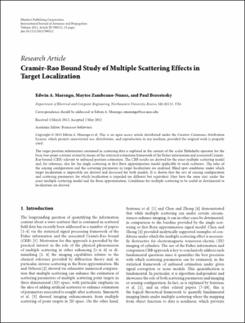Mostrar el registro sencillo del ítem
Cramér-Rao Bound Study of Multiple Scattering Effects in Target Localization
| dc.contributor.author | Marengo, Edwin A. | |
| dc.contributor.author | Zambrano Nuñez, Maytee | |
| dc.contributor.author | Berestesky, Paul | |
| dc.date.accessioned | 2017-07-31T16:32:15Z | |
| dc.date.accessioned | 2017-07-31T16:32:15Z | |
| dc.date.available | 2017-07-31T16:32:15Z | |
| dc.date.available | 2017-07-31T16:32:15Z | |
| dc.date.issued | 2012-07-04 | |
| dc.date.issued | 2012-07-04 | |
| dc.identifier.uri | http://ridda2.utp.ac.pa/handle/123456789/2373 | |
| dc.identifier.uri | http://ridda2.utp.ac.pa/handle/123456789/2373 | |
| dc.description | The target position information contained in scattering data is explored in the context of the scalar Helmholtz operator for the basic two-point scatterer system by means of the statistical estimation framework of the Fisher information and associated Cramér-Rao bound (CRB) relevant to unbiased position estimation. The CRB results are derived for the exact multiple scattering model and, for reference, also for the single scattering or first Born approximation model applicable to weak scatterers. The roles of the sensing configuration and the scattering parameters in target localization are analyzed. Blind spot conditions under which target localization is impossible are derived and discussed for both models. It is shown that the sets of sensing configuration and scattering parameters for which localization is impeded are different but equivalent (they have the same size) under the exact multiple scattering model and the Born approximation. Conditions for multiple scattering to be useful or detrimental to localization are derived. | en_US |
| dc.description.abstract | The target position information contained in scattering data is explored in the context of the scalar Helmholtz operator for the basic two-point scatterer system by means of the statistical estimation framework of the Fisher information and associated Cramér-Rao bound (CRB) relevant to unbiased position estimation. The CRB results are derived for the exact multiple scattering model and, for reference, also for the single scattering or first Born approximation model applicable to weak scatterers. The roles of the sensing configuration and the scattering parameters in target localization are analyzed. Blind spot conditions under which target localization is impossible are derived and discussed for both models. It is shown that the sets of sensing configuration and scattering parameters for which localization is impeded are different but equivalent (they have the same size) under the exact multiple scattering model and the Born approximation. Conditions for multiple scattering to be useful or detrimental to localization are derived. | en_US |
| dc.language | eng | |
| dc.language.iso | eng | en_US |
| dc.rights | https://creativecommons.org/licenses/by-nc-sa/4.0/ | |
| dc.rights | info:eu-repo/semantics/openAccess | |
| dc.subject | datos de dispersión | en_US |
| dc.subject | Fisher Información | en_US |
| dc.subject | límite de Cramer Rao | en_US |
| dc.subject | localización de objetivos | en_US |
| dc.subject | el modelo de dispersión múltiple | en_US |
| dc.subject | scattering data | en_US |
| dc.subject | Fisher Information | en_US |
| dc.subject | Cramer Rao bound | en_US |
| dc.subject | target localization | en_US |
| dc.subject | multiple scattering model | en_US |
| dc.subject | datos de dispersión | |
| dc.subject | Fisher Información | |
| dc.subject | límite de Cramer Rao | |
| dc.subject | localización de objetivos | |
| dc.subject | el modelo de dispersión múltiple | |
| dc.subject | scattering data | |
| dc.subject | Fisher Information | |
| dc.subject | Cramer Rao bound | |
| dc.subject | target localization | |
| dc.subject | multiple scattering model | |
| dc.title | Cramér-Rao Bound Study of Multiple Scattering Effects in Target Localization | en_US |
| dc.type | info:eu-repo/semantics/article | |
| dc.type | info:eu-repo/semantics/publishedVersion |
